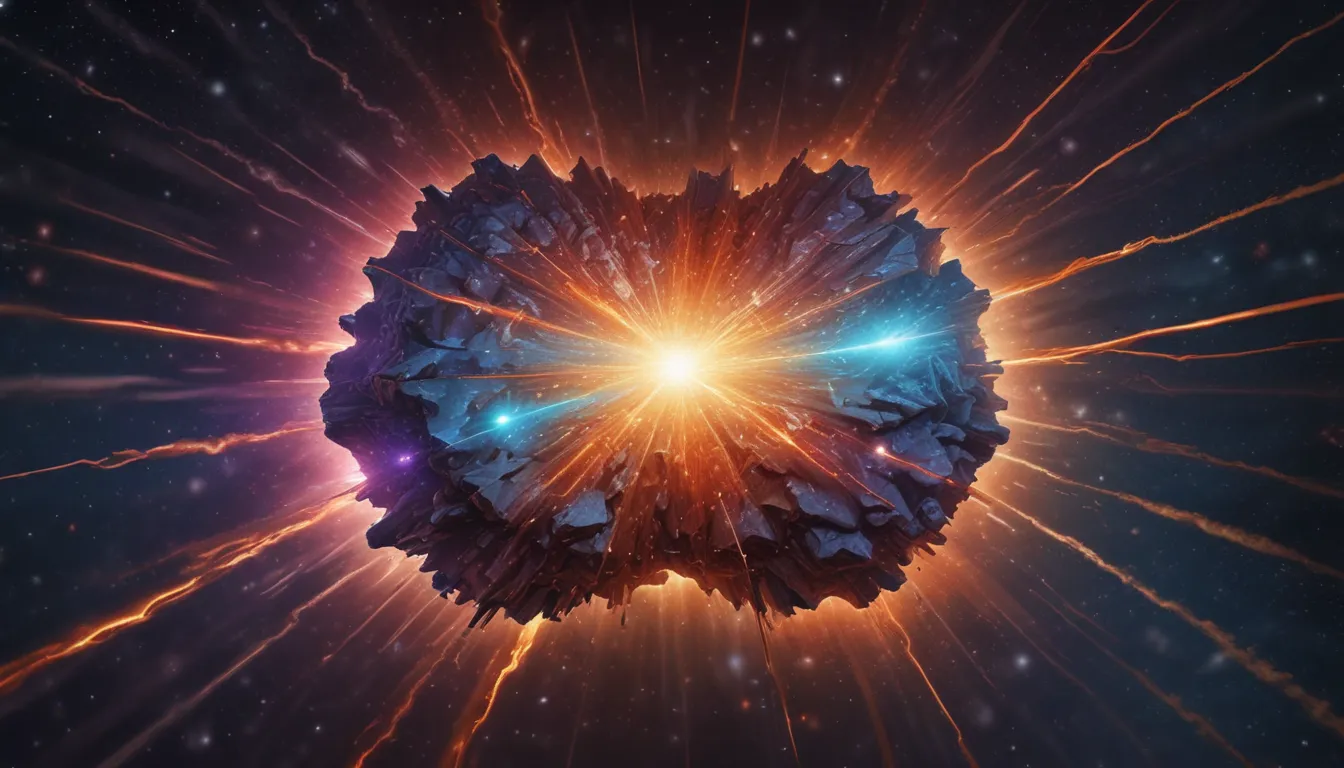The pictures we use in our articles might not show exactly what the words say. We choose these pictures to make you interested in reading more. The pictures work together with the words but don’t take their place. The words still tell you the important facts.
Welcome to the enthralling world of gamma-ray burst afterglows, where the universe's most powerful explosions leave behind a trail of astonishing revelations. These lingering emissions from distant galaxies hold the key to unraveling the secrets of black holes, understanding the expansion of the universe, and shedding light on exotic particles. Join us on an enlightening journey as we explore the mind-boggling facts surrounding gamma-ray burst afterglows and delve into the profound implications they have on our understanding of the cosmos.
Illuminating the Universe with Gamma-Ray Burst Afterglows
Gamma-Ray Burst (GRB) Afterglows are the electromagnetic remnants of the explosive bursts of high-energy photons known as gamma-ray bursts. These afterglows emit a wide range of radiation, from visible light to X-rays and radio waves, providing valuable insights into the most energetic events in the universe.
Unveiling the Enigmatic Nature of Gamma-Ray Burst Afterglows
The duration of a GRB afterglow can vary from a few hours to several months, depending on factors such as the energy of the initial burst and the distance from Earth. These afterglows not only illuminate the vast cosmos but also offer vital information about the formation of stars, black holes, and the fabric of space-time itself.
Shedding Light on the Expansion of the Universe
By analyzing the light curves and spectra of GRB afterglows, scientists can calculate the expansion rate of the universe. This valuable data, combined with redshift information, enables researchers to gain a deeper understanding of the universe's evolution and cosmic structure.
Capturing the Multifaceted Nature of Gamma-Ray Burst Afterglows
GRB afterglows radiate across the entire electromagnetic spectrum, making them visible at various wavelengths. State-of-the-art instruments on space telescopes and ground-based observatories allow astronomers to capture and study these emissions in visible light, X-rays, and radio waves, providing a comprehensive view of these cosmic phenomena.
Witnessing the Extraordinary Brilliance of Gamma-Ray Burst Afterglows
During the initial burst, gamma-ray emissions from GRBs can outshine the entire galaxy from which they originate. This exceptional brightness enables astronomers to detect these afterglows across vast distances, offering unparalleled insights into the universe's most cataclysmic events.
Exploring the Frontiers of Particle Physics with Gamma-Ray Burst Afterglows
The high-energy environment of GRB afterglows may harbor exotic particles such as axions or dark matter. By studying the emission properties of these afterglows, scientists hope to uncover clues about the existence and characteristics of these elusive particles, expanding our understanding of fundamental physics.
Embarking on a Cosmic Journey through Billions of Light-Years
GRBs are cosmic phenomena that occur in distant galaxies, with their light and radiation traveling billions of light-years to reach our telescopes. This incredible journey allows us to glimpse the universe's most dramatic events and gain insights into its evolution over vast cosmic timescales.
Illuminating the Dark Mysteries of Black Holes
GRBs are intricately linked to the collapse of massive stars and the formation of black holes. The afterglows of these cosmic explosions provide valuable data for studying the behavior and properties of black holes, including their mass, spin, and accretion processes.
Unveiling the Dynamic Jets of Gamma-Ray Burst Afterglows
The intense energy released during a gamma-ray burst gives rise to narrow jets of particles and radiation that travel at nearly the speed of light. These powerful jets contribute to the afterglow emissions observed from Earth, offering a glimpse into the energetic processes at play in these cosmic events.
Navigating the Interstellar Medium with Gamma-Ray Burst Afterglows
The interstellar medium, composed of gas and dust particles between galaxies, plays a crucial role in shaping the propagation and behavior of GRB afterglows. These interactions influence the observed characteristics and evolution of the afterglow emissions, highlighting the complex interplay between cosmic phenomena and their surroundings.
Peering into the Depths of the Early Universe with Gamma-Ray Burst Afterglows
The high energy and immense distances associated with GRBs enable astronomers to study the early universe. By examining the light from these afterglows, researchers can glean insights into the cosmic environment, the formation of the first stars and galaxies, and the fundamental processes that shaped the universe we see today.
Deciphering the Intricate Light Curves of Gamma-Ray Burst Afterglows
The brightness of GRB afterglows fluctuates over time, leading to complex light curves that offer valuable clues about the physics of the initial burst and its surrounding environment. These intricate patterns present scientists with engaging puzzles to solve, driving further exploration and discovery.
Testing the Bounds of Gravity with Gamma-Ray Burst Afterglows
GRB afterglows provide a unique opportunity to study the effects of gravity on high-energy particles and radiation. By observing the behavior of light near black holes and in strong gravitational fields, researchers can test the predictions of Einstein's theory of general relativity, unlocking new insights into the nature of spacetime and the dynamics of cosmic phenomena.
Embracing the Rarity and Unpredictability of Gamma-Ray Burst Afterglows
GRBs are rare, unpredictable events that occur randomly throughout the universe. Detecting the afterglow of these cosmic explosions requires a coordinated effort involving timely observations, extensive data analysis, and rapid communication between observatories worldwide, underscoring the challenging nature of studying these fleeting phenomena.
Continuing the Journey of Discovery with Gamma-Ray Burst Afterglows
Despite decades of research, gamma-ray burst afterglows continue to captivate scientists and researchers, driving them to push the boundaries of our knowledge of the cosmos. These remarkable cosmic beacons spark curiosity, inspire exploration, and offer a glimpse into the profound mysteries of the universe, inviting us to delve deeper into the enigmatic world of gamma-ray bursts and their afterglows.
Illuminating the Path Forward
In conclusion, the study of gamma-ray burst afterglows stands at the forefront of astrophysical research, offering a gateway to unparalleled discoveries and insights into the workings of the universe. Through a combination of cutting-edge technology, meticulous observations, and collaborative efforts, scientists are unraveling the mysteries hidden within these cosmic phenomena, paving the way for a deeper understanding of the cosmos and our place within it. As we continue to explore the captivating realm of gamma-ray burst afterglows, we embark on a journey of discovery and wonder, guided by the curiosity and ingenuity that drive us to unlock the secrets of the universe.
FAQs
-
What causes gamma-ray bursts?
Gamma-ray bursts are triggered by some of the most energetic explosions in the universe, such as the collapse of massive stars or the collision of neutron stars, releasing a vast amount of energy in the form of gamma-rays. -
How long do gamma-ray bursts and their afterglows last?
The initial burst of gamma-rays typically lasts for a few seconds to a few minutes, while the afterglow can persist for days, weeks, or even months. Studying these afterglows provides valuable information about the initial explosion. -
What can we learn from studying gamma-ray burst afterglows?
Studying gamma-ray burst afterglows offers insights into the formation of black holes, the creation of heavy elements, and the behavior of high-energy particles. It also enhances our understanding of the universe's evolution and its impact on Earth. -
How do scientists detect and study gamma-ray burst afterglows?
Scientists utilize a range of instruments, including satellites and ground-based telescopes, to detect and study gamma-ray bursts and their afterglows. These instruments can capture gamma-rays, X-rays, visible light, and other forms of radiation emitted during and after the bursts. -
Are gamma-ray bursts a threat to Earth?
While gamma-ray bursts are incredibly powerful and release substantial energy, they are typically distant from Earth and do not pose a direct threat. Scientists focus on studying these phenomena to enhance our understanding of the universe rather than developing measures to protect against them.
Embark on an awe-inspiring journey through the captivating realm of gamma-ray burst afterglows, where the mysteries of the universe unfold before your eyes. As we probe the depths of space and explore the cosmic phenomena that shape our existence, may the wonders of the cosmos inspire and enlighten you, guiding you on a path of discovery and understanding. Join us in unraveling the enigmatic secrets of gamma-ray burst afterglows, where science and curiosity converge to illuminate the boundless mysteries of the universe.






